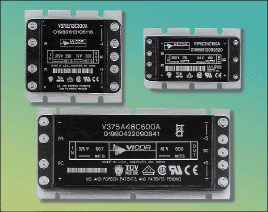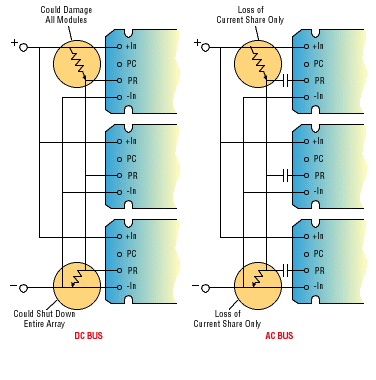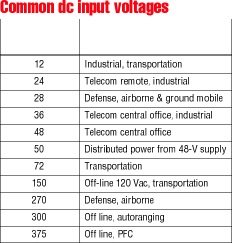Getting the most out of
component power systems
Understanding key issues ensures cost-effective, reliable power systems
BY ANDREW HILBERT
Vicor
Andover, MA Component-based power systems use high-density dc/dc converter modules, commonly called “bricks,” along with separate filters, front ends, and other power accessories. The component approach gives the designer almost unlimited flexibility in configuring a power system. To design a component power system that provides the power needed at a reasonable cost, the designer should consider issues such as application, converter technology, redundancy requirements, and agency certifications. With this information, the designer can narrow the selection process to the product lines most appropriate for the application. A power system designer who has extensive experience with a certain manufacturer's product can safely proceed with a system design with the use of these modules in mind. That's true as long as the designer knows that the manufacturer offers the input and output voltages and output powers required. Not a drop-in part One common misconception is that dc/dc converter bricks are a “slap a heat sink on it, drop it on the board, and it will work” component. A corollary is that all bricks are the same. These assumptions are only valid if the line and load are static, the system has a high degree of noise immunity, thermal conditions are benign, and only a moderate degree of dc isolation and regulation is needed. Unfortunately, this is rarely, if ever, the case. At the system level, it is rare that a Brand Y brick can be dropped into a Brand X slot with complete transparency unless the initial design included full evaluation of both bricks. This is true even with modules from various manufacturers having common form factors and pinouts. High-density, brick-type dc/dc converters offer many combinations of input voltage, output voltage, and power level (see Fig. 1 ).

Fig. 1. High-density, brick-type dc/dc converters offer many combinations of input voltage, output voltage, and power level.
In a typical system, the dc/dc modules need EMI filtering, transient protection, bypass capacitance, fusing, heat sinks, forced air, and possibly hold-up capacitance as well. All manufacturers have their own recommendations for the application of their modules. The novice design engineer especially needs to have early interaction with the supplier. Converter technology Some applications have requirements best suited to specific dc/dc converter technologies. For example, a system requiring very low conducted noise, noise sensitivity, or limited space for extensive filtering favors converters that rely on low-noise, quasiresonant zero-current, and zero-voltage switching. On the other hand, a system with severe thermal constraints, such as limited airflow and minimal space for heat sinking, favors low-voltage converters employing synchronous rectification for higher-power conversion efficiency. Redundancy One benefit of component power is the ease of implementing n + m redundancy at the module level. Most suppliers offer products with a single-wire paralleling scheme that allows for current sharing among bricks for both higher-output powers and redundant arrays. However, an often-overlooked failure point is the current-sharing bus itself. It is possible that an external failure (or an internal module failure) can create a short from the bus to ground or, even worse, a short to the line. In the former case, the entire array will most likely go down; in the latter case, all the modules in the array could be damaged. If the paralleling scheme employs a dc bus, this failure point is unavoidable. If an ac or pulse scheme (see Fig. 2 ) is used, blocking capacitors or even transformers can be employed to connect each brick to the bus.

Fig. 2. In a current-sharing scheme, an ac or pulsed signal gives designers the option of using capacitors or transformers to obtain dc-blocked coupling between the modules and current-sharing bus.
This results in a worst-case failure effect of loss of current sharing, not loss of output. If this is important for the system, then all products with a dc-current-sharing bus can be eliminated from consideration. Product range The power system designer who needs a 48-Vdc input and only a few standard outputs can choose from many manufacturers of high-density dc/dc converters that have standard 48-V-input bricks.

However, when other inputs and nonstandard outputs are needed, the potential supplier list begins to shorten. Table 1 shows common dc inputs and their applications. While many suppliers offer some inputs, only a few suppliers offer all of them. The designer should determine if there are other potential markets for the end equipment with different input needs than the primary market. If this is the case, the designer should select a supplier who can offer products suited for all potential end markets. That's a lot easier than redesigning the power system later to take advantage of new or secondary market opportunities. Agency approvals Similarly, it is important to know what agency approvals are required in different markets and countries. One benefit of component power is its “preapproved” agency status, which greatly expedites the required agency approvals of the system. Some key certifications include Austel, BABT, Bellcore, CSA, TÜV, UL, and VDE, as well as the CE mark. All of these certifications may not be needed, but before suppliers make it to the “short list,” designers should at least confirm that they can provide products with the minimum required certifications and approvals. Accessory components A power component system will not be complete without transient protection, EMI filtering, fusing, heat sinks, and other components. Many designers tackle these issues on their own. In this case, it is imperative that the brick supplier has, as a minimum, detailed application notes and preferably knowledgeable applications engineers. For those lacking the time, resources, or inclination, the alternative to “rolling your own” is to use modular accessories provided by the dc/dc converter supplier. These accessories include EMI filters, transient suppressors, standard heat sinks, and even in some cases sockets, fuses, X and Y capacitors, standoffs, output filters, hold-up capacitors, LEDs, and ORing diodes. Using modular accessories not only saves time, but also ensures that power system designs will work properly, thus minimizing design risks. The EMI filter, for instance, is designed to work with the converter modules. Assuming proper layout, the combination is certified to meet the specified EMC directives.
Advertisement





